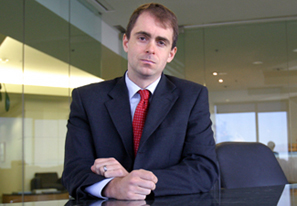
 Russ August & Kabat lawyers Larry C. Russ and Nathan D. Meyer co-authored an article, “Protectable Plaids,” which was published in the June 2011 issue of California Lawyer Magazine. A ruling last year in a battle between two apparel rivals offers guidance for future copyright claimants. In Express LLC v. Forever 21, Inc. (2010 WL 3489308 (C.D. Cal.), a Los Angeles federal judge rejected a manufacturer’s copyright claims based on the use of purportedly protectable plaid designs on shorts.
Russ August & Kabat lawyers Larry C. Russ and Nathan D. Meyer co-authored an article, “Protectable Plaids,” which was published in the June 2011 issue of California Lawyer Magazine. A ruling last year in a battle between two apparel rivals offers guidance for future copyright claimants. In Express LLC v. Forever 21, Inc. (2010 WL 3489308 (C.D. Cal.), a Los Angeles federal judge rejected a manufacturer’s copyright claims based on the use of purportedly protectable plaid designs on shorts.
Read the opinion.

 Russ August & Kabat is proud of Larry C. Russ and Michael S. Brophy who authored the article, “Arbitration: Beware of the Unintended Risks”, published in the Los Angeles Daily Journal. When an arbitrator makes a mistake, even clear errors of law, there is little that can be done to fix the decision.
Russ August & Kabat is proud of Larry C. Russ and Michael S. Brophy who authored the article, “Arbitration: Beware of the Unintended Risks”, published in the Los Angeles Daily Journal. When an arbitrator makes a mistake, even clear errors of law, there is little that can be done to fix the decision.
See Article.

 January 15, 2009
January 15, 2009
Celebrity battle over access ends — for now
A judge rules that ‘guests and invitees’ of South Beverly Park residents can enter the exclusive Westside community through the gates of adjacent North Beverly Park.
By Martha Groves
Los Angeles Times Staff Writer
In a decidedly uncivil war of haves versus haves, the South has prevailed against the North.
South Beverly Park, that is.
A Los Angeles County Superior Court judge tentatively ruled this week that “guests and invitees” of residents of the exclusive Westside community may enter through the gates of adjacent North Beverly Park.
The dispute went to court last spring after the 64-home North Beverly Park Homeowners Assn. began restricting access to a road that residents of the 16-home South Beverly Park neighborhood had been freely using for two decades.
Under the limitations, southern residents could continue to use the northern gates at Mulholland Drive.
But their nannies, gardeners and contractors had to take long detours on Benedict Canyon or Coldwater Canyon drives.
Northern residents defended the restrictions, citing security concerns and costs.
Among the South Beverly Park plaintiffs were Earvin “Magic” Johnson, Samuel L. Jackson and producer Richard Zanuck.
The northern defendants included Denzel Washington, Reba McEntire and media moguls Haim Saban and Sumner Redstone.
The battle is not over, said Jeffrey G. Huron, an attorney for the northern residents.
“It’s our intention to file written objections,” he said.
Huron added that the communities are separate and distinct.
“There is no reason why [southern] guests and invitees should not have to use the public streets like all of the other residents in the neighborhood that do not live in North Beverly Park,” he said.
Steve Goldberg, an attorney for the southern residents, said he expected the decision to stand.
If and when the ruling becomes final, he said, his clients intend to launch Phase 2: a claim for compensatory and punitive damages.
Goldberg said they also would seek reimbursement for attorney fees of $2 million and counting.
martha.groves@latimes.com

 Wednesday, December 10, 2008
Wednesday, December 10, 2008
In the Slowed Economy, Young Lawyers Are Giving Small Firms a Second Look
By Rebecca U. Cho
Daily Journal Staff Writer

LOS ANGELES – A year and a half after taking on a complex business case, Robert Satterthwaite was elated by a trial judge’s tentative ruling in July, awarding his client nearly $13 million in compensatory damages.
Satterthwaite, an associate, had reason to be pleased. Two years earlier, he had been at a large firm assisting partners on major cases as a part of a team – far from taking the lead role in a case of the magnitude like the one he had just handled.
But, after moving to the 20-attorney Russ August & Kabat in Los Angeles, Satterthwaite immediately began trial work on a matter involving a failed investment project in Malibu. Elyaszadeh v. Neman, BC328019 (L.A. Super. Ct., filed January 2005).
“It’s virtually unheard of at large firms where a [young] attorney is going to be lead counsel on a commercial litigation matter,” said Satterthwaite, who moved to the firm after nearly four years with the 200-attorney Munger, Tolles & Olson. He said he moved seeking more direct responsibility over trials.
The trend is nothing new. Satterthwaite is one of many young attorneys who in recent years have made the transition from big to small firms motivated by a desire for small-firm perks, such as immediate trial experience and a better work-life balance.
What is new, however, is that with the down economy, associates are finding it more difficult to land big-firm jobs. As a result, young lawyers are re-evaluating their options in the smaller-firm market – and sometimes it’s paying off.
“People may be discovering smaller firms by necessity more than anything else,” said Delia Swan, the founder of Swan Legal Search in Los Angeles. “But maybe this will educate young lawyers that there is this alternative.”
According to West’s Peer Monitor Index, which measures legal market conditions, associate hirings at firms, both big and small, are down 6 percent from last year, with the biggest factor confronting the legal industry being the “swelling of unproductive associates” at law firms.
Last month, San Francisco’s Orrick, Herrington & Sutcliffe laid off 40 lawyers and 35 staff members. Joining several other New York firms cutting costs, White & Case slashed 70 lawyers and 100 staff members from its ranks.
David Corwin, a legal recruiter with The Brunswick Group in Los Angeles, said the demand for his services has switched in recent months from associate to partner placements.
“With the economic downturn, law firms are more hesitant to expand their ranks,” Corwin said. “There are fewer positions out there.”
He said attorneys are becoming more open-minded to their job options. While he doesn’t foresee a significant shift in the number of young attorneys jumping to small firms, he said with the supply of associates outweighing the demand, attorneys are becoming less picky in their job searches.
“At first, when attorneys tread into the waters of new firms, they’re optimistic. Oftentimes, when they see how difficult is is to find a firm, they become more concerned,” Corwin said. “With that increased concern, there’s greater flexibility.”
Some boutique firm associates, such as David A. Hatch at Hooper, Lundy & Bookman, are breathing a little easier than their big-firm counterparts.
“Hooper is not as affected by the ebbs and flows of the economy,” said Hatch, who joined the 50-attorney firm after four years at Jones Day. “Being a health care firm, people have to get health care no matter what.”
But small firms are not immune from the economic downturn and are not necessarily faring better than the big ones. Productivity at law firms nationwide is down 4.5 percent in the third quarter, according to West’s Peer Monitor Index report. Those firms emphasizing corporate work or real estate, whether large or small, are suffering.
However, small firms, as a rule, tend to be less vulnerable to market swings because they don’t have major clients, which usually use big firms to handle huge financial matters.
“Smaller firms aren’t quite as impacted at this point by the economy like some larger firms because they’re not quite as involved in some major merger, M&A, banking financing schemes, or securitized loans,” said Larry Russ, the managing partner of Russ August & Kabat. “With that particular multimillion dollar business drying up, larger firms tend to feel the heat.”
Russ said as big firms and their associates become more realistic and open with each other, he is seeing an increase in lawyer referrals to his small firm directly from the big firms.
“I think associates who have mentors at various larger firms are being more honest about their long-term plans,” Russ said. “Associates are being more realistic, but the interchange is going back and forth. Law firms are more honest about associates’ prospects about becoming partner.”
Top law school graduates also are facing fewer choices than years past and are considering smaller firms, Swan said. They are considering work in less competitve geographic markets, such as Bakersfield, Fresno and Sacramento.
Swan said she hopes young attorneys will benefit from exploring their options during the hard economic times.
“As the economy goes back, they may find they like it [where they are],” she said.
rebecca_cho@dailyjournal.com
This article appeared on Page 1

 November 20, 2008
November 20, 2008
Hollywood stars sue over access to a neighborhood gate
Samuel L. Jackson, Denzel Washington, Eddie Murphy, Reba McEntire, Sylvester Stallone, Magic Johnson and Barry Bonds are involved in the lawsuit between North and South Beverly Park homeowners.
By Martha Groves
Los Angeles Times Staff Writer
A gated domain of sports stars, A-list actors, media billionaires and nouveau riche Angelenos — where 11,000 square feet constitutes a “cozy” house and a developer once built a $20-million manse on spec — is embroiled in a legal fracas that shows once and for all that money can’t buy happiness.
The court battle began in May, when residents of South Beverly Park sued their confreres in North Beverly Park.
These aren’t just any residents.
Among the South Beverly Park plaintiffs are Earvin “Magic” Johnson, Samuel L. Jackson and movie producer Richard Zanuck and his wife, Lili.
The North Beverly Park defendants include Denzel Washington, Eddie Murphy, Reba McEntire, Sylvester Stallone, Barry Bonds and media moguls Haim Saban and Sumner Redstone.
The dispute was touched off when the 64-home North Beverly Park Homeowners Assn. began restricting access to a road that residents of the 16-home South Beverly Park community had been freely using for two decades.
Under the new restrictions, the southern residents themselves could continue to enter through the northern gates at Mulholland Drive. But their contractors, nannies and gardeners, according to residents, had to take detours as long as seven miles on Benedict Canyon or Coldwater Canyon drives.
The communities, which carry a Beverly Hills post office address, are actually part of the city of Los Angeles. They are nestled between Mulholland Drive and Sunset Boulevard and Coldwater Canyon Drive and Beverly Glen Boulevard.
Within the gates are enormous mansions — in Tuscan, French chateau, Spanish and modern styles — set on large, flat lots of 1 to 3.5 acres. Of the handful of houses on the market, the most expensive is in the north, with an asking price of $50 million. The cheapest is $14 million.
Even the small and cheap mansions feature security gates and high stone walls, impeccably manicured lawns, tennis courts and pools.
“It’s a super unique enclave that gives you complete security, living among your peers,” said Mauricio Umansky, a real estate agent with Hilton & Hyland. “From every aspect, it’s just fantastic.”
Brian Adler, who helped develop the sister communities beginning in the mid-1980s, said the concept of having guards and gates was intended to make Beverly Park stand out from the other three top Westside neighborhoods, Beverly Hills, Holmby Hills and Bel-Air.
“It made sense that the highest-profile people would take interest,” Adler said.
For more than 20 years after the north gates were installed, according to South Beverly Park’s complaint, residents of the dual communities “enjoyed placid and neighborly relations.” All residents of South Beverly Park and their relatives, guests and “business invitees” had undisturbed access to the homes from the north.
In March 2006, the North Beverly Park homeowners group sent the south’s homeowners a letter demanding that they “pay their fair share of costs we [the north association] are incurring for maintenance of the roads, gates and security.” The amount specified was $121,000 a year.
Southern residents rejected the demand, and a volley of legal correspondence ensued, culminating in the northern group’s raising the amount it sought to $128,000, according to the complaint.
In May 2007, the northern residents informed their southern neighbors that their relatives, “staff, vendors and guests” would no longer be allowed to enter the northern neighborhood’s gates at Summitridge and Mulholland drives.
Plaintiffs stated in the complaint that the prohibition could result in absurd situations, such as denied access to a fiancee, grandparent or domestic partner of a South Beverly Park resident. The complaint added that construction vehicles, which were required to enter via the north gate at Mulholland, would be locked out of South Beverly Park because they could not navigate the narrow, steep streets above Sunset Boulevard.
The complaint said the conditions, covenants and restrictions for both the south and north developments “made clear that all of the residents of both . . . were to have free and full access through the north gates.” That provision, it added, “represented a valuable property right” for each South Beverly Park homeowner.
The restriction, the complaint said, thus diminished the value of properties in South Beverly Park, in addition to severely inconveniencing plaintiffs’ relatives, friends and others.
Steven Goldberg, an attorney for the plaintiffs, declined to comment. Jeffrey Huron, an attorney for the defendants, could not be reached.
Attorneys are expected to make their closing arguments Friday in Santa Monica Superior Court before Judge Norman P. Tarle.
One northern resident defended the restriction, citing security. “We don’t know these workers,” said Irena Medavoy, wife of movie producer Mike Medavoy. “We don’t know who’s coming in.” She added that requiring payment from southern residents was only fair, given that she and her neighbors in the north pay a few thousand dollars a month for security.
Medavoy, who considers her 11,000-square-foot East Coast traditional to be the small house on the block, sang the praises of Beverly Park, calling it a “wonderful place to live, with really terrific families.”
“We’re going to have to add extra security,” she said. “You have to stop them, know who’s coming through. We videotape them. Then you have the patrol cars.” Referring to Israel’s famed national intelligence service, she added: “It’s like Mossad security here.”

 August 13, 2008
August 13, 2008
Former Tennis Star Tracy Austin Accuses Broker Gary Fournier of Fraud
In a lawsuit, she says the L.A. investment broker inflated his commissions and ‘churned’ accounts to generate fees. He denies wrongdoing.
By Kim Christensen
Los Angeles Times Staff Writer
Former tennis champion Tracy Austin on Tuesday joined an all-star cast of sports figures in accusing a prominent Los Angeles investment broker of defrauding them.
In a civil lawsuit filed in Los Angeles County Superior Court, Austin and her husband, Scott Holt, alleged that Gary R. Fournier charged excessive commissions on bond trades and “churned” their accounts to generate fees from unnecessary transactions.
The couple claims damages “in excess of $500,000” on the trades, which allegedly occurred from 1994 to 2002, while Fournier worked for Salomon Smith Barney Inc. in Los Angeles. Its successor firm, Citigroup Global Markets Inc., also is named as a defendant.
Fournier, an investment advisor for more than 30 years, has denied wrongdoing. Citigroup declined to comment.
A member of the International Tennis Hall of Fame, Austin, 45, became the youngest U.S. Open champion in history in 1979 at age 16. She won the title again two years later and was ranked No. 1 in the world before her career was cut short by injuries.
Her allegations mirror those previously made against Fournier by other sports figures, including Los Angeles Lakers great Jerry West and General Manager Mitch Kupchak; former National Basketball Assn. players B.J. Armstrong and Stacey Augmon; and former Major League Baseball players Sean Douglass and Rex Hudler, now a member of the Angels broadcast team.
In a claim filed in 2007 with the Financial Industry Regulatory Authority, the investment industry group that licenses and regulates brokers, West and the others alleged that Fournier charged excessive commissions and churned accounts involving $300 million in trades he executed from 2002 to 2006 while with UBS Financial Services Inc. Sports agent Arn Tellem and his wife, Nancy Tellem, president of CBS Paramount Network Television Entertainment Group, are among those who claimed that Fournier gouged them to the collective tune of $3 million.
Their claim, which focused on Fournier’s actions but did not name him as a party to the case, is set to be heard by a three-member arbitration panel in September. It seeks unspecified damages from UBS, which has denied the allegations.
“Mr. Fournier has done nothing but look out for the financial interests of all of his clients and expects to be fully vindicated in the upcoming FINRA arbitration hearing,” said his lawyer, Michael Blumenfeld.
He called the allegations “unfounded and meritless” and said that “both the timing of Ms. Austin’s lawsuit and its filing in the Los Angeles Superior Court are highly suspect.”
“Any lawyer who commonly practices in this area of the law knows that Ms. Austin is required to pursue her claims before a securities arbitration tribunal — and cannot proceed in state or federal court,” he said. “The court filing therefore suggests nothing more than a litigation tactic.”
Attorney Steven M. Goldberg, who represents Austin and her husband, as well as West and the others, called Blumenfeld’s comments “desperate and preposterous” and contends the lawsuit was properly filed.
Arbitration panels can hear only matters that have occurred within the last six years, he said, whereas the statute of limitations for the court starts when the alleged wrongdoing is discovered.
Austin and her husband learned of the alleged fraud after reading a Los Angeles Times story about the West case in April, according to their lawsuit.

 Russ August & Kabat lawyers Larry C. Russ and Nathan D. Meyer co-authored an article, “Protectable Plaids,” which was published in the June 2011 issue of California Lawyer Magazine. A ruling last year in a battle between two apparel rivals offers guidance for future copyright claimants. In Express LLC v. Forever 21, Inc. (2010 WL 3489308 (C.D. Cal.), a Los Angeles federal judge rejected a manufacturer’s copyright claims based on the use of purportedly protectable plaid designs on shorts.
Russ August & Kabat lawyers Larry C. Russ and Nathan D. Meyer co-authored an article, “Protectable Plaids,” which was published in the June 2011 issue of California Lawyer Magazine. A ruling last year in a battle between two apparel rivals offers guidance for future copyright claimants. In Express LLC v. Forever 21, Inc. (2010 WL 3489308 (C.D. Cal.), a Los Angeles federal judge rejected a manufacturer’s copyright claims based on the use of purportedly protectable plaid designs on shorts. 

 Russ August & Kabat is proud of
Russ August & Kabat is proud of 
 January 15, 2009
January 15, 2009